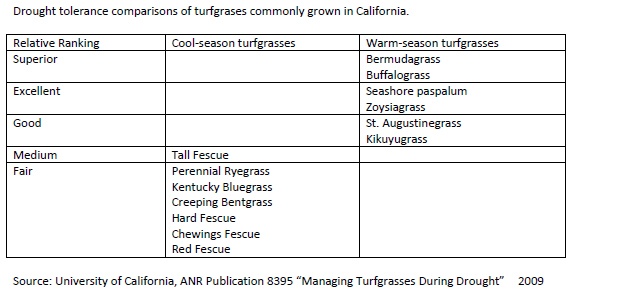WEEK 1
With the implementation of mandatory water restrictions in California one significant target for water savings has been on the landscape, particularly lawns. Contrary to popular belief, lawns do NOT have to be eliminated in order to achieve water savings. If you want a lawn and want to comply with restrictions. Here are some things to consider.
CHOOSING THE RIGHT TURF
First, choosing the right turf grass to begin with or replacing a lawn with a more drought tolerant species will often yield water savings of 25% or more.
All grasses are classified as either “warm season” or “cool season” grasses. The Mediterranean climate of California supports both types of grasses. While cool season grasses are more popular because of their year round green color, warm season grasses are better adapted at surviving extreme periods of drought because they are more efficient at using water. Warm season grasses generally save 25% or more water over cool season grasses. Within each category of grasses there are species that exhibit greater drought tolerance than other species.
Drought tolerance comparisons of turf grass commonly grown in California.

WARM SEASON TURF OPTIONS
General Characteristics. Warm season grasses perform best in southern, hot climates with mild winters. Keep in mind go dormant (brown) if the average soil temperature drops below 55F.
 Bermudagrass. The most widely grown warm season grass in California. Bermuda grass thrives in heat and spreads by both above ground (stolons) and below ground (rhizomes) runners. It is extremely popular for high use applications (sportsfields, golf courses) because of its’ rapid growth and recovery from injury. Improved varieties are Transcontinental, Sultan, and Yukon. Princess 77 is a seeded hybrid that has shown greater drought tolerance over common bermuda grass.
Bermudagrass. The most widely grown warm season grass in California. Bermuda grass thrives in heat and spreads by both above ground (stolons) and below ground (rhizomes) runners. It is extremely popular for high use applications (sportsfields, golf courses) because of its’ rapid growth and recovery from injury. Improved varieties are Transcontinental, Sultan, and Yukon. Princess 77 is a seeded hybrid that has shown greater drought tolerance over common bermuda grass.
 Buffalo grass. Native to the great plains of America it is a very low maintenance grass. According to studies, buffalo grass has the lowest water use rate of any commonly used tur fgrass. If not irrigated it will turn brown in summer but will recover with irrigation. It is a low growing grass that can be either mowed or left unmowed.
Buffalo grass. Native to the great plains of America it is a very low maintenance grass. According to studies, buffalo grass has the lowest water use rate of any commonly used tur fgrass. If not irrigated it will turn brown in summer but will recover with irrigation. It is a low growing grass that can be either mowed or left unmowed.
 Seashore paspalum. Similar in appearance to bermuda grass but does better along the coast. It is highly tolerant of salt water and poor soils. Improved variety “Seaspray” exhibits very good turf quality.
Seashore paspalum. Similar in appearance to bermuda grass but does better along the coast. It is highly tolerant of salt water and poor soils. Improved variety “Seaspray” exhibits very good turf quality.
 Zoysia grass. Has a high tolerance to heat, drought and traffic. Moderately tolerant to shade. Slow to establish. Spreads by stolons and rhizomes.
Zoysia grass. Has a high tolerance to heat, drought and traffic. Moderately tolerant to shade. Slow to establish. Spreads by stolons and rhizomes.
 St. Augustine grass. Vigorous summer grower, heat and drought tolerant. Spreads by stolons. Very good shade tolerance but not for high traffic areas. Not available in seed.
St. Augustine grass. Vigorous summer grower, heat and drought tolerant. Spreads by stolons. Very good shade tolerance but not for high traffic areas. Not available in seed.
 Kikuyu grass. Very similar in appearance to St. Augustine but more aggressive and able to withstand high traffic. Is tolerant of light shade conditions. Very good heat and drought tolerance especially in coastal climates. Unlike the other warm season grasses above, kikuyu has very little to no dormancy in winter months. Improved varieties include AZ-1 and Whittet. Kikuyu grass planting is restricted to Arizona, Hawaii and southern counties of California.
Kikuyu grass. Very similar in appearance to St. Augustine but more aggressive and able to withstand high traffic. Is tolerant of light shade conditions. Very good heat and drought tolerance especially in coastal climates. Unlike the other warm season grasses above, kikuyu has very little to no dormancy in winter months. Improved varieties include AZ-1 and Whittet. Kikuyu grass planting is restricted to Arizona, Hawaii and southern counties of California.
I have my favorites and am a big fan of Kikuyu, particularly because it doesn’t go fully dormant in winter months.
Here at Canyon Hydorseeding, we are able to seed any of these warm season grasses for far less than sod. Keep in mind, current rebates do not allow for alternative turf plantings. But if you want a lawn, and want to reduce water usage and save money, these are some good options.
Next week, we will talk about cool summer grass.
